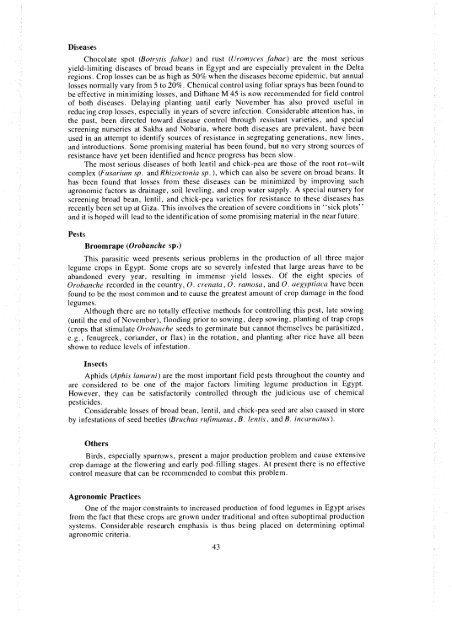I ARCHIV - International Development Research Centre
I ARCHIV - International Development Research Centre
I ARCHIV - International Development Research Centre
- No tags were found...
Create successful ePaper yourself
Turn your PDF publications into a flip-book with our unique Google optimized e-Paper software.
Diseases<br />
Chocolate spot (Botrytis fabae) and rust (Uromyces fabae) are the most serious<br />
yield-limiting diseases of broad beans in Egypt and are especially prevalent in the Delta<br />
regions. Crop losses can be as high as 50% when the diseases become epidemic, but annual<br />
losses normally vary from 5 to 20%. Chemical control using foliar sprays has been found to<br />
be effective in minimizing losses, and Dithane M 45 is now recommended for field control<br />
of both diseases. Delaying planting until early November has also proved useful in<br />
reducing crop losses, especially in years of severe infection. Considerable attention has, in<br />
the past, been directed toward disease control through resistant varieties, and special<br />
screening nurseries at Sakha and Nobaria, where both diseases are prevalent, have been<br />
used in an attempt to identify sources of resistance in segregating generations, new lines,<br />
and introductions. Some promising material has been found, but no very strong sources of<br />
resistance have yet been identified and hence progress has been slow.<br />
The most serious diseases of both lentil and chick-pea are those of the root rotwilt<br />
complex (Eusarium sp. and Rhizoctonia sp.), which can also be severe on broad beans. It<br />
has been found that losses from these diseases can be minimized by improving such<br />
agronomic factors as drainage, soil leveling, and crop water supply. A special nursery for<br />
screening broad bean, lentil, and chick-pea varieties for resistance to these diseases has<br />
recently been set up at Giza. This involves the creation of severe conditions in "sick plots''<br />
and it is hoped will lead to the identification of some promiiing material in the near future.<br />
Pests<br />
Broomrape (Orobanche sp.)<br />
This parasitic weed presents serious problems in the production of all three major<br />
legume crops in Egypt. Some crops are so severely infested that large areas have to be<br />
abandoned every year, resulting in immense yield losses. Of the eight species of<br />
Orobanche recorded in the country, 0. crenata, 0. ramosa, and 0. aegyptiaca have been<br />
found to be the most common and to cause the greatest amount of crop damage in the food<br />
legumes.<br />
Although there are no totally effective methods for controlling this pest, late sowing<br />
(until the end of November), flooding prior to sowing, deep sowing, planting of trap crops<br />
(crops that stimulate Orohwuhe seeds to germinate but cannot themselves be parasitized,<br />
e.g., fenugreek, coriander, or flax) in the rotation, and planting after rice have all been<br />
shown to reduce levels of infestation.<br />
Insects<br />
Aphids (Aphis lanurni) are the most important field pests throughout the country and<br />
are considered to be one of the major factors limiting legume production in Egypt.<br />
However, they can be satisfactorily controlled through the judicious use of chemical<br />
pesticides.<br />
Considerable losses of broad bean, lentil, and chick-pea seed are also caused in store<br />
by infestations of seed beetles Bruchus ruI,nanus, B. lentis, and B. incarnatus).<br />
Others<br />
Birds, especially sparrows, present a major production problem and cause extensive<br />
crop damage at the flowering and early pod-filling stages. At present there is no effective<br />
control measure that can be recommended to combat this problem.<br />
Agronomic Practices<br />
One of the major constraints to increased production of food legumes in Egypt arises<br />
from the fact that these crops are grown under traditional and often suboptimal production<br />
systems. Considerable research emphasis is thus being placed on determining optimal<br />
agronomic criteria.<br />
43

















